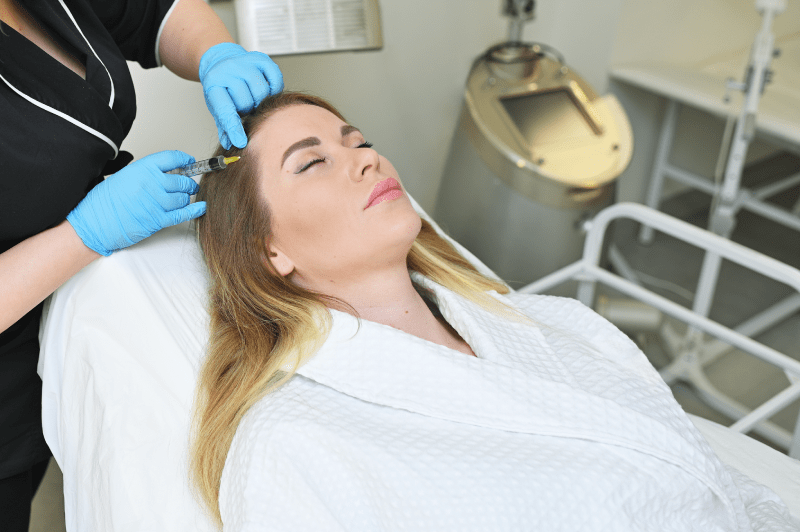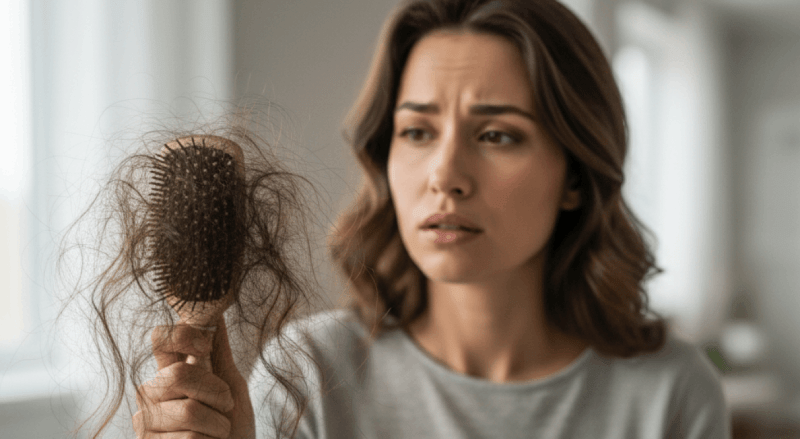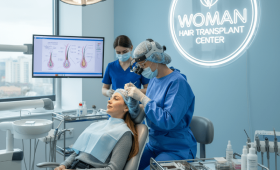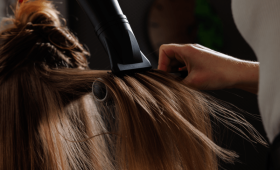What Are The Main Causes Of Hair Loss In Women?
Hair loss in women generally results from internal factors such as genetic predisposition (Androgenetic Alopecia), hormonal imbalances (menopause, PCOS, thyroid problems), and iron deficiency. Furthermore, intense stress, faulty diets, long-term use of certain medications, and seasonal changes can also trigger shedding. Accurate diagnosis is critical to determine the underlying cause and create a personalized treatment plan. Centers in Istanbul specializing in this field offer the most suitable solutions by identifying the source of the loss through comprehensive blood tests and hair analyses.
Why Should Istanbul Be Preferred For Hair Loss Treatment?
Istanbul hosts many centers that have international accreditation and invest in advanced technology in the field of hair loss treatments and hair transplantation. Experts in the city closely follow current scientific developments and apply the latest techniques such as FUE and DHI. Moreover, Istanbul has become a global health tourism destination due to the high quality of service offered at more affordable costs compared to centers in Europe and North America. It also offers the opportunity to turn the treatment process into a holiday experience where you can explore the city’s historical and cultural richness.
Is Hair Transplantation A Suitable Treatment For Women?
Hair transplantation offers a permanent and effective solution, especially for certain types of hair loss in women, such as hair thinning (Androgenetic Alopecia) or hairline recession. In women, transplantation can often be performed without shaving the entire head (unshaven FUE/DHI) or by shaving only a very small donor area, which reduces aesthetic concerns. The suitability of the treatment is determined on an individual basis by evaluating the type of hair loss, the density of the donor area, and the patient’s general health condition.
How Long Does The Hair Transplantation Operation Take In Women?
The duration of a hair transplantation operation in women generally varies between 4 and 8 hours, depending on the number of grafts to be transplanted and the technique preferred (DHI/FUE). Unshaven operations may sometimes take longer because the stages of graft harvesting and placement require more attention and precision. The patient’s comfort is ensured during the operation with local anesthesia, and an expert team works meticulously to harvest and place the grafts optimally.
How Is The FUE Technique Applied For Women’s Hair Transplantation?
The FUE (Follicular Unit Extraction) technique in women is usually applied by partially shaving a very small part of the donor area (mostly behind the ear or the nape). In this technique, hair follicles are harvested one by one using special micro motors or manual punches and placed into micro-incisions opened in the recipient area. This method is popular due to its minimal invasiveness and fast recovery. It is a successful method, especially preferred for filling sparse areas and increasing density.

Does The DHI Technique Yield Better Results In Women?
The DHI (Direct Hair Implantation) technique is quite popular among women because it allows for unshaven transplantation by placing hair roots directly using Choi implanter pens. This technique combines the processes of channel opening and root placement in a single step, which potentially increases the survival rate of the grafts by reducing their exposure to air. Furthermore, it helps achieve more natural and dense results by allowing for more precise adjustment of the angle and direction of implantation.
How Are Hair Transplantation Costs Determined In Istanbul?
Hair transplantation costs in Istanbul vary depending on the technique applied, the number of grafts to be transplanted, additional services included in the treatment (accommodation, transfers, PRP sessions), and the overall quality of service provided by the center. Prices are generally offered as a package, allowing you to receive European-standard quality at more affordable prices compared to Western countries. For the most accurate price information, a hair analysis must be performed, and the exact number of grafts needed must be determined.
What Is The Recovery Process Like After Hair Transplantation?
The recovery process after hair transplantation generally takes 10-14 days. During this period, slight redness, scabbing, and swelling may be observed in the transplanted and donor areas. The scabs begin to fall off within 7-10 days with the help of special lotions and shampoos provided after the first wash. Adhering strictly to the doctor’s instructions during the recovery period (sleeping position, medication use) is vital for the healthy survival of the grafts and rapid healing.
How Effective Is PRP Treatment Against Hair Loss?
PRP (Platelet-Rich Plasma) treatment is based on injecting plasma, which is obtained from the patient’s own blood and rich in growth factors, into the scalp. These factors stimulate existing hair follicles, encourage hair in the resting phase (telogen) to enter the growth phase (anagen), and significantly slow down hair loss. It is a natural method that yields excellent results, especially in early-stage hair loss and as a supportive treatment before/after hair transplantation.
How Does Mesotherapy Strengthen Hair Roots?
Hair mesotherapy is the process of injecting a special mixture of vitamins, minerals, and amino acids, which are necessary for hair roots, directly into the middle layer of the scalp using micro-needles. This procedure increases blood circulation and helps the roots strengthen by delivering the nutrients required by the hair follicles directly to the target. When applied in regular sessions, it helps to thicken hair strands and reduce shedding, while providing vitality and shine.
Who Is Laser Therapy Treatment Recommended For?
Low-level Laser Therapy (LLLT) is generally recommended for women who have mild to moderate hair loss but do not yet require a hair transplant, or who want to accelerate healing after transplantation. This treatment improves blood flow by increasing the energy production of cells in the hair roots and extends the growth phase. This non-surgical and painless method is applied in regular sessions at home or in the clinic to support and improve hair quality.
How Does Hormonal Balance Affect Hair Loss?
Hormonal imbalances, especially conditions like thyroid problems, menopause, and polycystic ovary syndrome (PCOS), are among the most common triggers for hair loss in women. Increased androgen hormones lead to the weakening of hair follicles. In this case, the success of hair loss treatment is directly related to the treatment of the underlying hormonal problem in collaboration with an endocrinologist. Procedures such as hair transplantation also yield more permanent results after hormonal balance is achieved.
Is There A Solution For Postpartum Hair Loss?
Postpartum hair loss (Telogen Effluvium) is a common condition associated with the rapid drop in estrogen levels after delivery, which had been elevated during pregnancy. This condition usually starts 3-6 months after birth and resolves spontaneously within a year. Supportive treatments like B vitamins, iron and zinc supplements, or nourishing mesotherapy or PRP sessions can be considered to alleviate shedding during this period. Hair transplantation is usually not required for this type of hair loss.
Which Vitamins And Minerals Are Important For Hair Loss?
The most critical vitamins and minerals for hair health are Biotin (B7), Iron, Zinc, Vitamin D, and Vitamin B12. Iron deficiency is one of the most common causes of hair loss in women and requires supplementation. Biotin supports the production of keratin, the building block of hair, while zinc helps the hair follicle function healthily. These supplements must be determined individually, under doctor supervision and based on blood test results.
What Preparations Should Be Made Before Hair Transplantation?
To ensure a successful operation, there are important points patients should pay attention to before hair transplantation. These include stopping smoking and alcohol consumption at least one week before the operation, and discontinuing the use of blood-thinning medications (like aspirin) and certain vitamin supplements. Furthermore, special shampoos may be recommended to ensure the scalp is clean and healthy. All these preparations aim to make the operation more comfortable and maximize the graft survival rate.
When And How Should The First Wash Be Done After Hair Transplantation?
The first wash after hair transplantation is usually performed by the center itself or taught in detail to the patient 2 or 3 days after the operation. This critical wash must be done with great care to avoid damaging the transplanted grafts. A special foam lotion and medical shampoo are used, the water pressure is adjusted, and the washing is completed with very gentle touches using the fingertips. The correct first wash is essential to control the formation of scabs and reduce the risk of infection.

How Long Does It Take For Transplanted Hair To Fully Grow Out?
The process for transplanted hair to grow out permanently and for full results to be visible is generally completed within 12 to 18 months. A temporary shedding called “shock loss” occurs within the first month after the operation, which is completely normal. Hair begins to regrow from the 3rd month, a visible density forms by the 6th month, and by the end of the 1st year, most of the hair thickens and takes its final appearance.
How Is The Donor Area Determined And Protected In Women?
In women, the donor area is usually selected from areas that are genetically resistant to hair loss, such as the nape or behind the ear. This area is a section where the hair is naturally denser and where the number of grafts taken will not spoil the general appearance of the hair. Specialists protect the aesthetics of the donor area by harvesting the grafts uniformly and carefully to prevent thinning. In women, the donor area can often be easily concealed thanks to the unshaven FUE technique.
Is Pain Or Discomfort Felt After Hair Transplantation?
Since hair transplantation is performed under local anesthesia, no pain is felt during the operation. After the effect of the anesthesia wears off, there may be a slight tension, ache, or itching in the donor area and the transplanted area. These discomforts are easily controlled with standard painkillers prescribed by the doctor and usually last only for the first few days. Most patients find the post-operative process surprisingly comfortable.
Why Is It Important To Get Expert Support For Hair Loss?
Seeking expert support in hair loss treatment is vital for the accurate diagnosis of the complex underlying causes of shedding. If a surgical procedure like hair transplantation is being considered, it is essential to be in the hands of an experienced and competent specialist for a successful and natural result. Specialists determine the most suitable treatment method for your hair type, shedding pattern, and general health condition, preventing wasted time and costs.
Are Accommodation And Transfer Services Available For Treatments In Istanbul?
Leading health centers in Istanbul and intermediaries like Cure Holiday offer package services for the comfort of international patients. These packages generally include VIP transfers between the airport and the clinic, and suitable and comfortable accommodation options for your recovery period. These services are provided to ensure that patients coming from abroad can focus on their treatment and go through their process in Istanbul without stress.
How Is A Natural Appearance Ensured In The Transplanted Area?
To achieve a natural look, the specialist performing the transplant must be extremely experienced in the natural exit angle of the hair (15-45 degrees), direction, and most importantly, the front hairline design. Density balance is achieved by transplanting single grafts to the front line and denser grafts to the back areas. In transplants performed by experienced hands, no scars or artificial appearance occur when the new hair grows out.
How Is Hairline Design Done In Women?
Hairline design in women is an extremely meticulous and personalized process that takes into account facial features, age, forehead structure, and the patient’s aesthetic expectations. For a natural appearance, the hairline should be soft and transitional, not sharp-lined as in men. Specialists aim for a natural, youthful, and feminine look by mimicking the natural growth direction of the patient’s hair and adjusting the distance between the eyebrows and the forehead optimally.
Is It Possible To Perform Hair Transplantation On Wide Areas?
Yes, it is possible to perform hair transplantation in women for thinning and balding in wide areas caused by genetic hair loss. However, sufficient donor area is very important to ensure a natural density in such wide areas. If the donor capacity is limited, planning is done to achieve maximum coverage and density in the first session, and in some cases, a second session may be necessary.
What Are The Drug Treatments Used Besides Hair Transplantation?
Among the medical treatments used besides hair transplantation, the most common is Minoxidil containing topical solutions. These drugs help slow down hair loss and strengthen existing hair. In cases of hormonal hair loss in women, oral medications containing anti-androgens may also be prescribed under doctor supervision. All drug treatments must be used with a specialist doctor’s diagnosis and prescription.
Which Tests Are Performed For Hair Loss Diagnosis?
For determining the cause of hair loss, a detailed physical examination and Trichoscopic analysis (microscopic examination of the hair and scalp) are usually performed. Additionally, blood tests are done to check thyroid hormones (TSH, T3, T4), iron stores (Ferritin), zinc, B12, and Vitamin D levels. These tests are indispensable for detecting hormonal or nutritional deficiency-related hair loss.
How Should The Scalp Be Protected From The Sun After Hair Transplantation?
Protection from the sun’s rays is critical for the first few months after hair transplantation because UV rays can damage the transplanted skin and affect the pigmentation of the newly emerging hair roots. Direct sun exposure should be strictly avoided for the first 15 days. In the following period, loose and wide-brimmed hats should be used or high-factor sunscreen should be applied with the doctor’s approval.

What Are The Wrong Hair Care Habits That Trigger Hair Loss?
Common wrong habits that trigger hair loss include tying hair too tightly (traction alopecia), exposing it to excessive heat (blow drying, curling irons), frequent chemical treatments (dye, perm), and using shampoos containing harsh chemicals. Aggressive combing methods that irritate the scalp can also lead to shedding. It is important to be gentle with the scalp and prefer natural products.
Can Stress-Related Hair Loss Be Treated?
Yes, severe stress-related hair loss (Telogen Effluvium) is a temporary condition and tends to resolve spontaneously when the stress factor is eliminated or managed. Learning stress management techniques, adequate sleep, and a balanced diet play a major role in the treatment process. Supportive treatments such as vitamin supplements, PRP, and mesotherapy can be used to accelerate the healing process.
Can You Go Swimming In The Pool Or Sea After Hair Transplantation?
Swimming in the pool or sea should be strictly avoided for the first one month after hair transplantation. Chlorine in pools and salt water in the sea can damage the delicate newly transplanted grafts and increase the risk of infection. Specialists recommend waiting for this period for the grafts to fully settle and the scalp to heal.
How Does The Number Of Grafts Affect Hair Transplantation Success?
The number of grafts is the most important factor directly affecting the success of hair transplantation in terms of density and coverage. When a sufficient number and quality of grafts suitable for the patient’s needs are transplanted, a natural and full appearance is achieved. However, success depends not only on the number of grafts but also on their correct placement angle and homogeneous distribution. Experienced specialists determine the optimum number of grafts that will not exceed the patient’s donor capacity.
Do Alternative Medicine Methods Work For Hair Loss?
Alternative medicine methods for hair loss do not replace scientifically proven treatment methods, but they can be used as a support. For instance, certain herbal oils or natural massage techniques can benefit the scalp by increasing blood circulation. However, if there is a serious medical reason underlying the shedding, modern medical treatments should be applied as a priority under expert supervision, rather than relying solely on alternative methods.
Is Translation Support Provided During The Treatment Process In Istanbul?
In Istanbul, which is a major center for international health tourism, professional translation services are provided throughout your treatment process. Health tourism intermediaries like Cure Holiday will support you in your native language throughout your communication process, from clinic admission to post-operative follow-up, guaranteeing that you understand all medical information accurately and completely.
How Is Personalized Planning Done In Hair Loss Treatment?
Personalized planning is vital because every patient’s hair loss pattern, donor area quality, general health condition, and aesthetic expectations are completely different. Specialists first conduct detailed analyses to determine the cause and severity of the shedding. They then choose the most suitable option from medical treatment (PRP/Mesotherapy) or surgical intervention (Hair Transplantation) to create a treatment roadmap unique to you.
How Is The Treatment Process Started Through Cure Holiday?
Contacting Cure Holiday is the easiest and most reliable way to start your hair loss treatment journey in Istanbul. All you need to do is request a free consultation via their website or communication channels. Experienced consultants will contact you to evaluate your hair photos, provide information on treatment options and estimated costs, and help you plan your entire treatment package, including accommodation and transfers.
Are you ready to find a permanent and reliable solution for your hair loss in Istanbul? You can contact Cure Holiday to create your personalized treatment plan right away.



